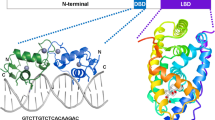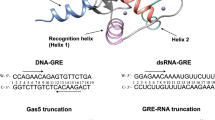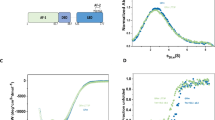Abstract
STEROID hormone receptors activate specific gene transcription by binding as hormone-receptor complexes to DNA enhancer elements termed hormone responsive elements (refs 1, 2 and references therein). A highly conserved 66-amino-acid region of the oestrogen and glucocorticoid receptors which corresponds to part of the receptor DNA-binding domain (region C) determines the specificity of target gene recognition3–5. This region contains two subregions (CI and CII), encoded in two separate exons (refs 1, 7 and references therein), that are analogous to the 'zinc fingers' of the transcription factor TFIIIA (reviewed in ref. 6). The N-terminal CI finger determines the recognition specificity of the hormone responsive element8. A chimaeric oestrogen receptor, in which the CI finger is replaced with the corresponding glucocorticoid receptor CI finger region, activates transcription from a reporter gene containing a glucocorticoid-responsive element, but not from a reporter gene containing an oestrogen-responsive element8. We report here that three amino acids located at the C-terminal side of the oestrogen receptor CI finger play a key part in this specificity.
This is a preview of subscription content, access via your institution
Access options
Subscribe to this journal
Receive 51 print issues and online access
$199.00 per year
only $3.90 per issue
Buy this article
- Purchase on Springer Link
- Instant access to full article PDF
Prices may be subject to local taxes which are calculated during checkout
Similar content being viewed by others

References
Green, S. & Chambon, P. Trends Genet 4, 309–314 (1988).
Evans, R. M. Science 240, 889–895 (1988).
Green, S. & Chambon, P. Nature 325, 75–78 (1987).
Kumar, V. et al Cell 51, 941–951 (1987).
Kumar, V. & Chambon, P. Cell 55, 145–156 (1988).
Klug, A. & Rhodes, D. Trends biochem. Sci 12, 464–469 (1987).
Ponglkitmongkol, M., Green, S. & Chambon, P. EMBO J. 7, 3385–3388 (1988).
Green, S., Kumar, V., Theulaz, I., Wahli, W. & Chambon, P. EMBO J. 7, 3037–3044 (1988).
Klein-Hitpaß, L., Schorpp, M., Wagner, U. & Ryffel, G. U. Cell 46, 1053–1061 (1986).
Berg, J. M. Proc. natn. Acad. Sci. U.S.A. 85, 99–102 (1988).
Gibson, T. J., Postma, J. P. M., Brown, R. S. & Argos, P. Protein Engng 2, 209–218 (1988).
Witte, M. M. & Dickson, R. C. Molec. cell. Biol. 8, 3726–3733 (1988).
Klock, G., Strähle, U. & Schütz, G. Nature 329, 734–736 (1987).
Martinez, E., Givel, F. & Wahli, W. EMBO J. 6, 3719–3727 (1987).
Ham, J., Thompson, A., Needham, M., Webb, P. & Parker, M. Nucleic Acids Res. 16, 5263–5276 (1988).
Arriza, J. L. et al. Science 237, 268–275 (1987).
Umesono, K., Giguère, V., Glass, C. K., Rosenfeld, M. G. & Evans, R. M. Nature 336, 262–265 (1988).
Petkovtah, M., Brand, N. J., Krust, A. & Chambon, P. Nature 330, 444–450 (1987).
Green, S., Issemann, I. & Scheer, E. Nucleic Acids Res. 16, 369 (1988).
Misrahi, M. et al. Biochem. biophys. Res. Commun. 143, 740–748 (1987).
Chang, C., Kokontis, J. & Liao, S. Proc. natn. Acad. Sci. U.S.A. 85, 7211–7215 (1988).
Hollenberg, S. M. et al. Nature 318, 635–641 (1985).
Green, S. et al. Nature 320, 134–139 (1986).
Brand, N. et al. Nature 332, 850–853 (1988).
Weinberger, C. et al. Nature 324, 641–646 (1986).
Baker, A. R. et al. Proc. natn. Acad. Sci. U.S.A 85, 3294–3298 (1988).
Author information
Authors and Affiliations
Rights and permissions
About this article
Cite this article
Mader, S., Kumar, V., de Verneuil, H. et al. Three amino acids of the oestrogen receptor are essential to its ability to distinguish an oestrogen from a glucocorticoid-responsive element. Nature 338, 271–274 (1989). https://doi.org/10.1038/338271a0
Received:
Accepted:
Issue Date:
DOI: https://doi.org/10.1038/338271a0
This article is cited by
-
Mutations in the vitamin D receptor and hereditary vitamin D-resistant rickets
BoneKEy Reports (2014)
-
Specificity of DNA-binding by the FAX-1 and NHR-67 nuclear receptors of Caenorhabditis elegans is partially mediated via a subclass-specific P-box residue
BMC Molecular Biology (2008)
-
Oestrogen-receptor-mediated transcription and the influence of co-factors and chromatin state
Nature Reviews Cancer (2007)
-
Ligand-dependent switching of ubiquitin–proteasome pathways for estrogen receptor
The EMBO Journal (2004)
-
Regulation of prothymosin α by estrogen receptor α: molecular mechanisms and relevance in estrogen-mediated breast cell growth
Oncogene (2002)
Comments
By submitting a comment you agree to abide by our Terms and Community Guidelines. If you find something abusive or that does not comply with our terms or guidelines please flag it as inappropriate.


